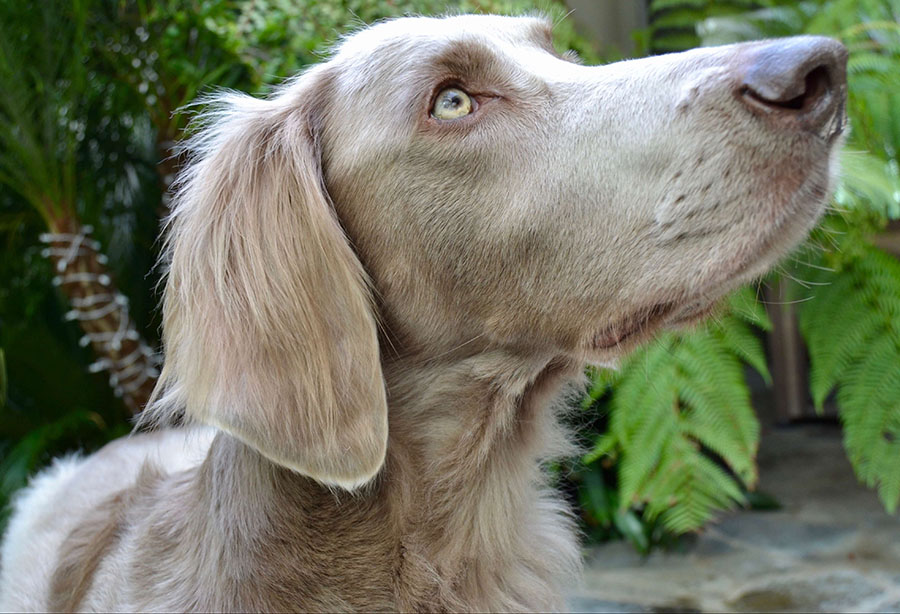The noble gray coat and amber eyes make the Weimaraner absolutely unique. The relatively young hunting breed from Germany is increasingly finding its way into families. Here in the profile, you’ll find everything about the history, character, and care of the breed.
History of the Weimaraner
There is generally little known about the ancestors of the Weimaraner. Initially, the breed was rare and locally known around the city of Weimar in Thuringia. Hunters and foresters bred these beautiful hunting dogs here. It is documented that Grand Duke Karl August of Saxe-Weimar-Eisenach kept some silver hunting dogs at his court in Weimar as early as the beginning of the 19th century.
The breeders at that time did not place much emphasis on a uniform appearance, and there were also long-haired representatives, which are rather rare today. It wasn’t until 1897 that the Weimaraner Club e.V. began breeding the silver-gray dog according to a uniform standard.
Since the breed was registered, breeders have not crossed it with other breeds, making the Weimaraner the oldest German pointing breed. In the United States, President Dwight Eisenhower’s female dog popularized the breed in the 1950s. Americans primarily breed the dog for its appearance and as a well-behaved family pet. In Germany, however, breeding dogs require a hunting performance test, and breeders primarily give their puppies to hunters. Due to its noble appearance, more and more people want to keep a Weimaraner as a family pet. The FCI classifies the breed in FCI Group 7.1 Continental Pointing Dogs.
Breed Overview
GROUP: Sporting
HEIGHT: 25 to 27 inches (males); 23 to 25 inches (females)
WEIGHT: 70 to 90 pounds (males); 55 to 75 pounds (females)
COAT: Short and stiff
COAT COLOR: Various shades of gray
LIFE SPAN: 11 to 13 years
TEMPERAMENT: Powerful, steady, intelligent, stubborn, energetic, aloof, alert
HYPOALLERGENIC: No
ORIGIN: Germany
Traits and Characteristics
The Weimaraner is an exceptionally intelligent and confident hunting dog with a strong predatory instinct. This means that he tracks and kills game on command. They are suspicious of strangers and need some time to warm up to new people. The protective instinct is very strong, and the self-confident dog doesn’t hesitate to defend its family or territory. However, it does not have excessive temperament. The hunting dog is very affectionate and, with good training, can become a great lifelong companion. In general, you should not leave the Weimaraner alone for long periods, as it becomes nervous and barks.
| Affection Level | High |
| Friendliness | High |
| Kid-Friendly | High |
| Pet-Friendly | Medium |
| Exercise Needs | High |
| Playfulness | High |
| Energy Level | High |
| Trainability | High |
| Intelligence | High |
| Tendency to Bark | Medium |
| Amount of Shedding | Low |

How to Care for a Weimaraner?
Considerations Before Acquisition:
First and foremost, the Weimaraner is a purebred hunting dog that also wants to be used accordingly. For this reason, registered breeders of the Weimaraner Club of America prefer to give their puppies to hunters and foresters. To preserve the hunting dogs as such, we do not place much emphasis on breeding for appearance. However, if you engage intensively with the dog and provide enough exercise, it can also be happy as a pure family pet without hunting activities. But you should have enough experience with dogs so that the Weimaraner does not overwhelm you.
So, if you decide on one of the silver hunting dogs, you should visit a registered breeder. You may need to convince them first that you are capable of properly caring for the dog. Be careful if blue or black puppies are sold as special features, as these are actually disqualified from the breed standard. For a purebred and healthy puppy, you should budget around $1000. If you don’t want to spend that much money and want to do a good deed, check out the animal shelter. Here you may sometimes find one of the gray hunting dogs in need, to whom you can give a new loving home.
Consistent Puppy Training:
The Weimaraner relies on a strong and confident caregiver for consistent training. It’s best if you already have experience with dogs and understand the specific needs of a hunting dog. Especially if you’re not using him for hunting, you need to control his hunting instinct early on. If the strong-willed dog does not accept you as the leader, training will be difficult. With a good balance of patience and authority, you should make it clear to the puppy who is in charge from an early age. Violence and aggression are completely inappropriate. To ensure he gets along well with other dogs later on, the Weimaraner must be socialized as a puppy. It’s best to attend puppy classes where he can meet and play with other dogs.

Activities with the Weimaraner
The Weimaraner wants to express his innate intelligence and need for movement. As an original hunting dog, he needs an appropriately stimulating activity if you’re not using him for hunting. Sufficient exercise and mental stimulation are part of the daily routine. Long walks in nature are an absolute must. But it’s best to also engage him in a dog sport like mantrailing or professional dummy training. The dog enjoys retrieving from water and can be enthusiastic about scent-based search games. Perhaps you can also get the Weimaraner excited about jogging, cycling, or hiking, allowing you to engage in sports together.
Health and Grooming
The short, shiny coat of the hunting dog does not require special care. It’s completely sufficient to groom it regularly. The long-haired representatives of the breed should naturally receive a bit more grooming. The dog’s diet should be adjusted to its level of physical activity and not be too fatty. The dogs also tend to eat their food too quickly, which can cause bloat. So, it’s better to feed them small portions multiple times a day and avoid strenuous activities after meals. Health-wise, the Weimaraner is generally a robust breed with a life expectancy of 10 to 14 years. One of the most well-known hereditary diseases is hip dysplasia, so you should carefully examine the parent animals before purchasing.

Interesting Facts
The Weimaraner is a star in the USA:
In the United States, the Weimaraner has been a very popular pet since President Dwight Eisenhower acquired his dog Heidi in 1956. Even Frank Sinatra and Grace Kelly were proud owners of a “Grey Ghost,” as the breed is admiringly called. During the Cold War, the Americans deployed a male named Dingo as a bomb-sniffing dog. His task was to locate fragments of test rockets so that soldiers could examine them. Since he worked in the desert, he wore a terry cloth coat filled with ice cubes. The famous American photo artist William Wegman uses the breed as a motif for his artworks. His two most famous dogs were named Man Ray and Fay.
Did you know?
- At birth, Weimaraner puppies have black tiger stripes on their fur, which disappear after a few days.
- In young Weimaraners, the eyes are still blue, but the color changes to a brown tone as they age.
- Since Weimaraners were bred for hunting wild game, they are among the fastest dogs, reaching speeds of up to 55 kilometers per hour.
- The dogs are true escape artists and enjoy using their intelligence to learn how to open doors or overcome fences.
Do you also have a Weimaraner or are you planning to get one soon? Tell me in the comments what makes him so special!


